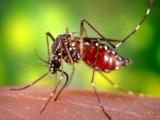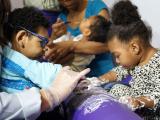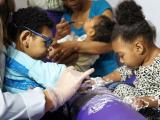In a pair of Zika studies today, researchers reported that requests for abortion through an online group have increased in some Latin American countries where the procedure is illegal, and a group in Brazil described eye complications in an adult man infected with the virus.
Both reports were published in letters in the New England Journal of Medicine.
Abortion demand in Latin America
An unusual feature of the Zika virus outbreak is that although the disease is generally mild, it can cause severe birth defects, including microcephaly, in babies born to women infected during pregnancy. With no treatment or vaccine available, childbearing-age women have been advised to take steps to avoid mosquito bites and in some instances to postpone pregnancy. Women in some of the hard-hit countries, however, have little or no access to contraceptives or abortion.
The letter on abortion is from Women on Web (WoW), which has been an option for women in Latin America for several years. The nonprofit group provides access to abortion medications through online telemedicine in countries where safe abortions aren't universally available.
To see if the demand for abortion services through WoW rose after the Pan American Health Organization (PAHO) issued an alert about the Zika threat in November 2015, researchers from the group and collaborators from the United States and the United Kingdom looked at requests from Jan 1, 2010, to Mar 2, 2016, from 19 Latin American countries. They divided the countries into three groups: local transmission where abortion is legally restricted, no local transmission where abortion is legally restricted, and local transmission where abortion is legally restricted and there are no national advisories.
For comparison, they also examined patterns for three countries for which increases in Zika-based requests weren't expected: Chile, Poland, and Uruguay.
Requests for WoW abortion services increased significantly in Latin American countries that warned pregnant women about Zika virus complications.
The method of gauging abortion demand might underestimate the impact of country advisories, because many women may have used an unsafe method, obtained abortion drugs through other means, or visited underground providers, the group wrote. They added that accurate data on women's choice are tough to obtain, but their data provide a window on how worries about Zika virus infection may have affected pregnant women in Latin America.
With World Health Organization (WHO) models estimating that 3 million to 4 million people in the Americas will be infected by Zika virus through early 2017, other countries where safe abortion access is restricted are bound to be affected, the team said. "Official information and advice about potential exposure to the Zika virus should be accompanied by efforts to ensure that all reproductive choices are safe, legal, and accessible."
Eye complication potential for adults
In a separate report, Brazilian researchers described uveitis in a man in his early 40s who had a lab-confirmed Zika infection along with typical symptoms, including conjunctivitis. The report appears to be the first for an eye complication related to the virus in an adult, aside from conjunctivitis, one of the disease's main symptoms.
Though the main concern about Zika virus has been about its congenital effects, some rare complications have been reported in adults, such as Guillain-Barre syndrome and myelitis. Eye-related birth defects have been reported in babies of Zika-infected women.
In the wake of West Africa's Ebola outbreak, uveitis and other eye problems were identified as a complication in some patients, and aqueous humor is one of the immune-protected areas that can harbor Ebola virus after it clears the bloodstream.
Eight days after symptom onset, the patient's eye exam revealed conjunctival hyperemia in both eyes, along with uveitis findings. An aqueous humor sample from the patient's right eye tested positive for Zika RNA on reverse-transcriptase polymerase chain reaction testing and at a lower amount than in his serum. Doctors prescribed topical ciprofloxacin-dexamethasone for the patient's right eye.
Eye findings were seen 8 days after the drug was administered, along with worsened vision in his left eye, but an aqueous humor sample from the patient's left eye was negative for Zika virus RNA.
The man received topical glucocorticoid treatment for 7 days, after which his visual acuity returned to baseline, with no signs of uveitis on physical exam. Researchers said the man's serologic and intraocular samples were negative for dengue virus, and there were no clinical or lab findings for other infections.
They concluded that some people with Zika-related conjunctivitis may have intraocular inflammation, with uveitis as a possible Zika virus complication.
Other research developments
- Screening with the new CRISPR/Cas9 gene editing technique has identified proteins that Zika and dengue viruses need to replicate. Researchers based at the University of Massachusetts Medical School published their findings yesterday in Cell Reports. They started by using CRISPR screening technology already developed for dengue and influenza, deleting each protein in the human genome one at a time to see how Zika or dengue survived in its absence. The scientists identified a handful of human host proteins that were critical for virus replication, including the AXL protein. They said the findings suggest possible drug targets.
- Immune response from mosquito saliva in the skin after a bite can help viruses such as those that cause Zika and dengue to establish infections more quickly, researchers based at the University of Leeds reported yesterday in the journal Immunity. The team also found that the immune response can also spread the infection in the body, increasing the threat of severe illness. Using a mouse model, they found that the saliva triggers an immediate immune response involving neutrophils and myeloid calls, which can become infected and inadvertently replicate the virus. They injected the skin of mice with and without the presence of a mosquito bite and compared reactions. In the absence of a bite, the viruses didn't replicate well, but in a bite setting, high virus levels were detected in the skin. In a university press release, research fellow and lead author Clive McKimmie, PhD, said, "This was a big surprise we didn't expect. These viruses are not known for infecting immune cells."
See also:
Jun 22 N Engl J Med letter on abortion requests
Jun 22 N Engl J Med letter on uveitis





















